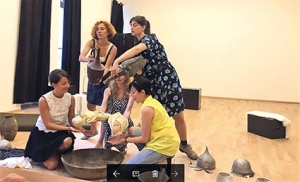Young Actors Perform Oldest Caucasus Epos in Georgian & Ossetian
The Nart Sagas, one of the oldest Caucasus eposes, received a second life on the stage of the Shota Rustaveli Theater and Film State University of Georgia. A group of young actors performed the ancient stories of courage, friendship and love in both Georgian and Ossetian.
The Nart Sagas are a series of tales originating from the North Caucasus. They form the basic mythology of the tribes in the area, including Abazin, Abkhaz, Circassian, Ossetian, Karachay-Balkar, and Chechen-Ingush folklore.
The theatrical performance, which was attended by over 100 representatives of the Georgian government, civil society and international organizations, opened with welcome remarks from Dr. Naira Bepieva, Professor at Georgian-Ossetian Relations Research Center of Iv. Javakhishvili Tbilisi State University and Chair of a non-governmental organization “Caucasian Mosaic”, and representatives of the European Union (EU) and United Nations Development Program (UNDP).
The performance was received warmly by the audience and received positive feedback.
According to Dr. Bepieva, the performance itself is the part of the important peaceful mission implemented in collaboration with the EU and UNDP.
“This is a peace-keeping mission aimed at restoring Georgian-Ossetian relations and building confidence. Accordingly, it is a matter of a great importance nowadays. We presented the performance in three parts: in Georgian, in Ossetian and the last one in both languages. We have been working together with the EU and UNDP for years. With their financial support, we have already published unique editions of Georgian-Ossetian and Ossetian-Georgian dictionaries and an adapted and illustrated version of the Nart Sagas for children. Today’s performance is part of the abovementioned processes. It is also noteworthy that young people from Georgia and Tskhinvali are involved in it, performing with great enthusiasm and love: that is the reason why the spectators were so satisfied after the performance,” she noted.
The performance was also attended by the students of the Tbilisi Classical Gymnasium, interested in studying the Nart Epos. As Dr. Naira Bepieva said, it was yet another opportunity for them to enhance their knowledge about the oldest Cucasus epos and learn more about the universal human values.
“By attending today’s performance, the young children had the opportunity to compare the Nart Sagas to Georgian, Greek and Egyptian myths and draw interesting parallels between them. They might become the Ambassadors of Peace of the feature, as the treasure created by the people is valuable for everyone who wants to build peace and confidence among the members of society,” she added.
Director of the theatrical performance, Tamar Khizanishvili, told reporters that the main message she wanted to deliver to the audience was that taking care of each other and preserving peaceful relations are the most important issues nowadays.
“This is a play about the Nart Epos and how we perceive it in complicated Georgian-Ossetian relations. The Nart Epos are a series of stories about diginity and universal human values. Bringing the oldest Caucasus epos onto the stage was no easy task, but thanks to our excellent group, the performance turned out very successful. My personal message to the audience was that we should take care of each other as much as possible. At the end of the performance, there is a shot depicting an empty land, without humans – this is what I wanted to express. I am from Tskhinvali myself and I would say that no-one wants to live in a war-torn land. Accordingly, we must be very careful and take care of each other, otherwise, one day, we may also find ourselves in an empty space,” Khizanishvili explained.
The Nart Sagas were adapted for the theater in summer 2018 by the organization ‘Caucasian Mosaic’ in collaboration with Shota Rustaveli Theater and Film State University of Georgia. The theatrical adaptation followed the illustrated Georgian-Ossetian edition of Nart Sagas for Children published in 2017. The book is illustrated by Georgian and Ossetian artists and is circulated in schools and libraries in Tbilisi and Tskhinvali.
The initiative was supported by the European Union (EU) and UNDP under their joint program for building confidence between conflict-divided communities, the Confidence Building Early Response Mechanism (COBERM).
The Nart Sagas is one of 190 confidence-building initiatives supported under the COBERM since 2010. Working closely with civil society organizations on all sides of conflict divides, the EU and UNDP addressed some of the key confidence building areas, such as youth education, people diplomacy, cultural cooperation, minority rights, gender equality, environment protection, healthcare and more. The ongoing third phase of COBERM will be completed in December 2018.
By Ana Dumbadze











